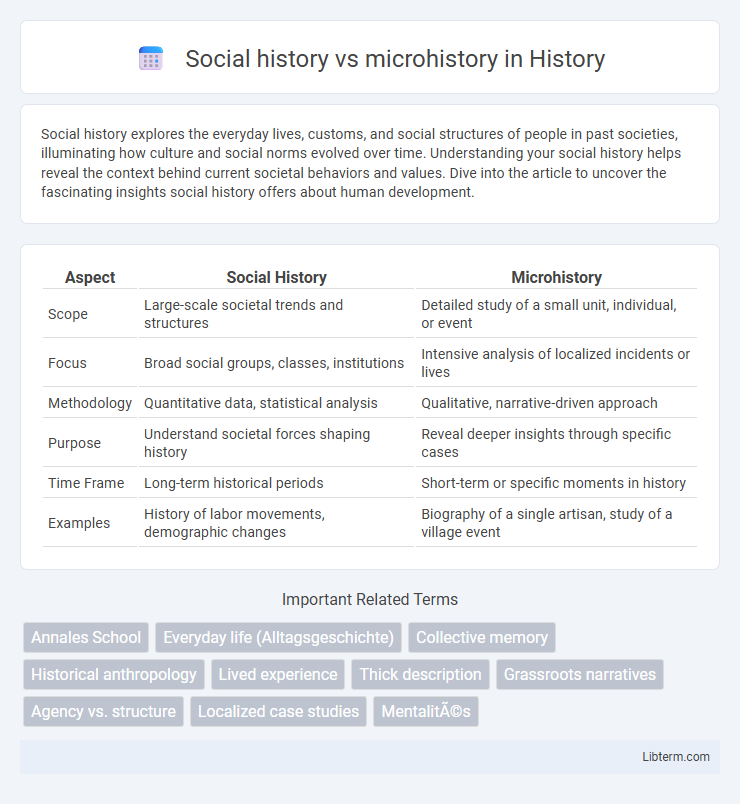Social history explores the everyday lives, customs, and social structures of people in past societies, illuminating how culture and social norms evolved over time. Understanding your social history helps reveal the context behind current societal behaviors and values. Dive into the article to uncover the fascinating insights social history offers about human development.
Table of Comparison
| Aspect | Social History | Microhistory |
|---|---|---|
| Scope | Large-scale societal trends and structures | Detailed study of a small unit, individual, or event |
| Focus | Broad social groups, classes, institutions | Intensive analysis of localized incidents or lives |
| Methodology | Quantitative data, statistical analysis | Qualitative, narrative-driven approach |
| Purpose | Understand societal forces shaping history | Reveal deeper insights through specific cases |
| Time Frame | Long-term historical periods | Short-term or specific moments in history |
| Examples | History of labor movements, demographic changes | Biography of a single artisan, study of a village event |
Defining Social History: Scope and Focus
Social history examines broad patterns of societal change, emphasizing the lives of ordinary people within large social structures from a macro perspective. It integrates economic, cultural, and demographic data to analyze collective behaviors, social classes, and institutions over extended periods. Microhistory narrows this scope by focusing on in-depth studies of individuals or small communities to reveal detailed social dynamics often overlooked in broader analyses.
Understanding Microhistory: An In-Depth Perspective
Microhistory delves into the detailed experiences of individuals or small communities, providing nuanced insights into historical events often overshadowed by broader social trends. Unlike social history, which analyzes large-scale social structures and patterns, microhistory emphasizes deep contextual understanding through meticulous examination of specific cases. This approach uncovers the complexities of everyday life, revealing how personal narratives intersect with and challenge dominant historical narratives.
Key Methodologies in Social History
Social history employs quantitative data analysis, oral histories, and archival research to explore broad societal trends and everyday experiences across different populations. It emphasizes collective experiences through demographic studies, census data, and social statistics to understand class structures, labor movements, and family dynamics. Microhistory focuses on intensive examination of individual events or communities, using close reading of primary sources and detailed narrative techniques to reveal broader historical patterns.
Microhistory’s Unique Research Approaches
Microhistory employs detailed case studies and intensive archival research to uncover everyday experiences and marginalized voices often overlooked by broader social history narratives. It emphasizes granular analysis of specific events or individuals to reveal complex social dynamics and cultural practices within localized contexts. This approach allows microhistorians to challenge generalizations and highlight diversity within historical processes by focusing on richly textured, small-scale investigations.
Comparing Scales: Macro vs. Micro
Social history examines broad societal patterns and large-scale structures, analyzing collective behaviors and long-term trends across regions or nations. Microhistory focuses on detailed studies of specific individuals, small communities, or singular events to reveal deeper insights into everyday life and local experiences. Comparing scales, social history provides a macro perspective on historical processes, while microhistory offers a micro lens that uncovers nuanced complexities often overlooked by broader analyses.
Sources and Evidence in Both Fields
Social history relies heavily on diverse sources such as census records, newspapers, and official documents to reconstruct broad patterns of everyday life across large populations. Microhistory emphasizes detailed examination of limited sources like court records, personal letters, and diaries to uncover the lived experiences of individuals or small communities. Both fields triangulate evidence to understand historical contexts, but social history prioritizes quantitative data while microhistory values qualitative depth and narrative specificity.
Case Studies in Social History
Social history emphasizes large-scale societal patterns and structures, using case studies to illustrate broader social phenomena and collective experiences. Microhistory focuses on detailed, intensive examination of a single event, community, or individual, revealing nuanced insights that challenge generalizations in social history. Case studies in social history bridge macro and micro perspectives, providing empirical evidence that highlights social dynamics within specific contexts.
Prominent Microhistory Examples
Microhistory emphasizes detailed analysis of specific individuals or small communities to reveal broader social patterns, differing from social history's wider focus on large-scale societal trends. Prominent microhistory examples include Carlo Ginzburg's *The Cheese and the Worms*, which explores the worldview of a 16th-century miller, and Natalie Zemon Davis's *The Return of Martin Guerre*, examining identity and social norms in 16th-century France. These case studies provide rich qualitative insights that challenge generalized historical narratives by highlighting the complexity of lived experiences.
Impact on Historical Interpretation
Social history emphasizes broad patterns and structures, analyzing large-scale social processes and trends to understand historical contexts. Microhistory concentrates on detailed case studies of individuals or small communities, providing deep insights that challenge or enrich mainstream narratives. The impact on historical interpretation lies in social history's ability to reveal general societal dynamics while microhistory offers nuanced perspectives that complicate or humanize those larger frameworks.
Future Trends: Integrating Social History and Microhistory
Future trends in historical research emphasize the integration of social history and microhistory to create richer, multidimensional narratives. Combining large-scale social patterns with detailed individual experiences allows historians to uncover nuanced insights into cultural, economic, and political transformations. Advanced digital tools and data analytics will further enable scholars to synthesize macro-level trends with microhistorical case studies, enhancing historical scholarship and public understanding.
Social history Infographic

 libterm.com
libterm.com